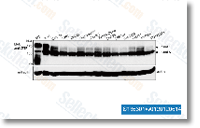Resistance to signalling inhibitors Resistance to tar geted signal transduction agents is prevalent, arising via a number of mechanisms together with utilisation of compen satory feedback loops or choice signalling pathways. Systems biology applications have begun to describe these dynamic improvements, and therefore are vital to identify important target points for successful therapeutic intervention. Robust recommendations are certainly not however employed in scientific studies assessing the efficacy of novel ther apeutics. This kind of rigour is important to make sure that both ap propriate models and quantitative outputs are thoroughly utilised. The ideal drug combinatorial approaches could selleckchem GSK2118436 then be de veloped based mostly on mechanistic insight into opportunities afforded by synthetic lethality.
More sophisticated experimental designs of DNA injury response defects and those that accurately reflect mechanisms of treatment resistance will allow the style and design of targeted thera pies to conquer these clinically related concerns. What are the key gaps in our expertise and how might they be filled Drug responses selleck inhibitor We lack a complete have an understanding of ing of the exact mechanisms by which medication exert anti cancer effects in vivo, that is ex acerbated by our incomplete appreciation of networks, cross talk and redundancy in cell signalling. Provided that multiple inhibitors of unique pathways are now readily available, harmonised approaches to prioritisation of particular inhibitors/inhibitor courses and of exploration objectives in clinical trials are necessary.
Clinical determinants of intrinsic and acquired resist ance There exists incomplete knowing from the part of diverse gene expression, epigenetic, protein and non coding RNA changes while in the heterogeneous  manifesta tions of clinical resistance, There exists a lack of equivalence concerning clinical, pathological, proliferative and molecular resistance that wants to be addressed and single genes or even a canonical pathway are unlikely to be responsible. Additionally, numerous mechanisms have also been implicated in acquired resistance, but their re lationship to intrinsic resistance remains to become defined. Figure five illustrates the heterogeneity in patterns of gene expression in clinical endocrine resistance, suggesting that no less than three key molecular mechanisms could be concerned. There exists a really need to comprehend the clinical effect of additional hormone receptors aside from ER, primarily the progesterone receptor, whilst PR is prognostic, the Group review hasn’t demonstrated a predictive worth. Very similar considerations apply to ERB and also the androgen receptor, considering the fact that trials of anti androgens are at the moment underway in metastatic breast cancer. It can be not clear no matter if you will discover distinctions in ER ve premenopausal vs. postmenopausal endocrine resistance.
manifesta tions of clinical resistance, There exists a lack of equivalence concerning clinical, pathological, proliferative and molecular resistance that wants to be addressed and single genes or even a canonical pathway are unlikely to be responsible. Additionally, numerous mechanisms have also been implicated in acquired resistance, but their re lationship to intrinsic resistance remains to become defined. Figure five illustrates the heterogeneity in patterns of gene expression in clinical endocrine resistance, suggesting that no less than three key molecular mechanisms could be concerned. There exists a really need to comprehend the clinical effect of additional hormone receptors aside from ER, primarily the progesterone receptor, whilst PR is prognostic, the Group review hasn’t demonstrated a predictive worth. Very similar considerations apply to ERB and also the androgen receptor, considering the fact that trials of anti androgens are at the moment underway in metastatic breast cancer. It can be not clear no matter if you will discover distinctions in ER ve premenopausal vs. postmenopausal endocrine resistance.
Natural Product
A natural product is a chemical compound or substance produced
